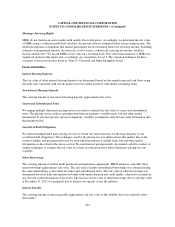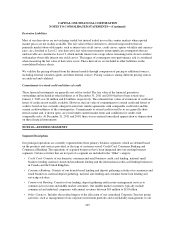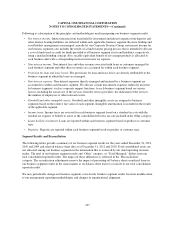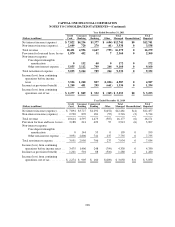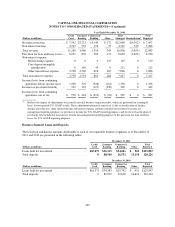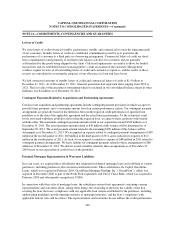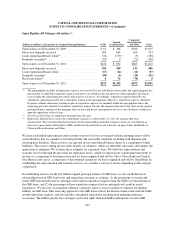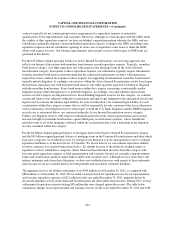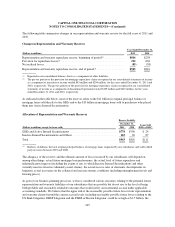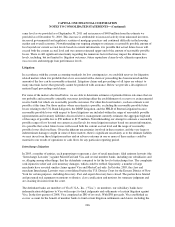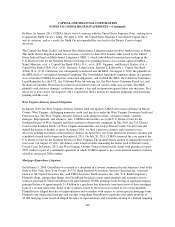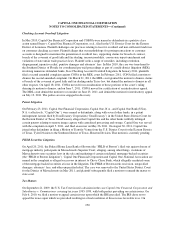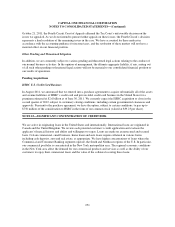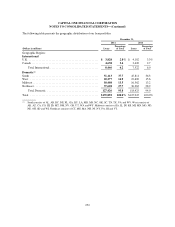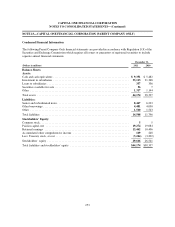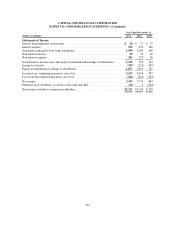Capital One 2011 Annual Report Download - page 264
Download and view the complete annual report
Please find page 264 of the 2011 Capital One annual report below. You can navigate through the pages in the report by either clicking on the pages listed below, or by using the keyword search tool below to find specific information within the annual report.CAPITAL ONE FINANCIAL CORPORATION
NOTES TO CONSOLIDATED STATEMENTS—(Continued)
contracts typically do not contain prompt notice requirements for repurchase requests or materiality
qualifications to the representations and warranties. Moreover, although we often disagree with the GSEs about
the validity of their repurchase requests, we have established a negotiation pattern whereby the GSEs and our
subsidiaries continually negotiate around individual repurchase requests, leading to the GSEs rescinding some
repurchase requests and our subsidiaries agreeing in some cases to repurchase some loans or make the GSEs
whole with respect to losses. Our lifetime representation and warranty reserves with respect to GSE loans are
grounded in this history.
For the $13 billion original principal balance in Active Insured Securitizations, our reserving approach also
reflects our historical interaction with monoline bond insurers around repurchase requests. Typically, monoline
bond insurers allege a very high repurchase rate with respect to the mortgage loans in the Active Insured
Securitization category. In response to these repurchase requests, our subsidiaries typically request information
from the monoline bond insurers demonstrating that the contractual requirements around a valid repurchase
request have been satisfied. In response to these requests for supporting documentation, monoline bond insurers
typically initiate litigation. Accordingly, our reserves within the Active Insured Securitization are not based upon
the historical repurchase rate with monoline bond insurers, but rather upon the expected resolution of litigation
with the monoline bond insurers. Every bond insurer within this category is pursuing a substantially similar
litigation strategy either through active or probable litigation. Accordingly, our representation and warranty
reserves for this category are litigation reserves. In establishing litigation reserves for this category, we consider
current and future losses inherent within the securitization and apply legal judgment to the anticipated factual and
legal record to estimate the lifetime legal liability for each securitization. Our estimated legal liability for each
securitization within this category assumes that we will be responsible for only a portion of the losses inherent in
each securitization. Our litigation reserves with respect to both the U.S. Bank Litigation and the DBSP Litigation,
in each case as referenced below, are contained within the Active Insured Securitization reserve category.
Further, our litigation reserves with respect to indemnification risks from certain representation and warranty
lawsuits brought by monoline bond insurers against third-party securitizations sponsors, where GreenPoint
provided some or all of the mortgage collateral within the securitization but is not a defendant in the litigation,
are also contained within this category.
For the $6 billion original principal balance of mortgage loans in the Inactive Insured Securitizations category
and the $81 billion original principal balance of mortgage loans in the Uninsured Securitizations and other whole
loan sales categories, we establish reserves by relying on our historical activity and repurchase rates to estimate
repurchase liabilities over the next twelve (12) months. We do not believe we can estimate repurchase liability
for these categories for a period longer than twelve (12) months because of the relatively irregular nature of
repurchase activity within these categories. Some Uninsured Securitization investors from this category who
have not made repurchase requests or filed representation and warranty lawsuits are currently suing investment
banks and securitization sponsors under federal and/or state securities laws. Although we face some direct and
indirect indemnity risks from these litigations, we have not established reserves with respect to these indemnity
risks because we do not consider them to be both probable and reasonably estimable liabilities.
The aggregate reserves for all three subsidiaries were $943 million as of December 31, 2011, as compared with
$816 million as of December 31, 2010. We recorded a total provision for repurchase losses for our representation
and warranty repurchase exposure of $212 million for the year ended December 31, 2011, primarily driven by
increased repurchase activity from Uninsured Securitizations and other whole loan investors. During 2011, we had
settlements of repurchase requests totaling $85 million that were charged against the reserve. The table below
summarizes changes in our representation and warranty reserves for the years ended December 31, 2011 and 2010.
244


